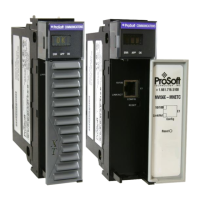MVI56E-MNETC/MNETCXT ♦ ControlLogix Platform Reference
Modbus TCP/IP Client Enhanced Communication Module - Client/Server User Manual
ProSoft Technology, Inc. Page 123 of 172
September 20, 2018
Controller Tags
The MNETC.CONTROL controller tag array holds all the values needed to create
one Command Control block, have it sent to the module, and control the
processing of the returned response block.
Enter a decimal value representing the quantity of commands to be
requested in the Command Control block (1 to 16). This value is
used by the ladder logic to generate the Command Control Block ID.
The rightmost digits of the Command Control Block ID are the
number of commands requested by the block.
Enter the Client to issue the commands to (0 to 29)
Enter the ROW NUMBER of the command in the MNET Client x
Command List in Prosoft Configuration Builder minus 1. This is a
16-element array. Each element holds one Command Index.
Enter a 1 (enable) or a 0 (disable) to select which commands on the
configuration's Client x Command List will be executed during
routine polling. There is one 16-bit word for each of the 30 Clients.
Each of the 16 bits corresponds to one of the 16 commands
available to each Client. The state of these WriteCmdBits overrides
whatever value may be assigned to the Enable parameter in the
configuration.
Note: This parameter only affects routine polling. It has no effect on
Command Control blocks.
Set this tag to 1 to trigger the execution of a Command Control
block after all the other parameters have been entered.
Pass-Through Blocks (9956 to 9961, 9970 and 9996)
In Pass-Through mode, write messages sent to a server port are passed directly
through to the processor. In this mode, the module sends special blocks to the
processor when a write request is received from a Client. Ladder logic must
handle the receipt of these blocks and place the enclosed data into the proper
controller tags in the processor.
There are two basic modes of operation when the pass-through feature is
utilized: Unformatted (code 1) and Formatted (code 2 or 3). In the unformatted
mode, messages received on the server are passed directly to the processor
without any processing. These unformatted blocks require more decoding than
the formatted blocks.

